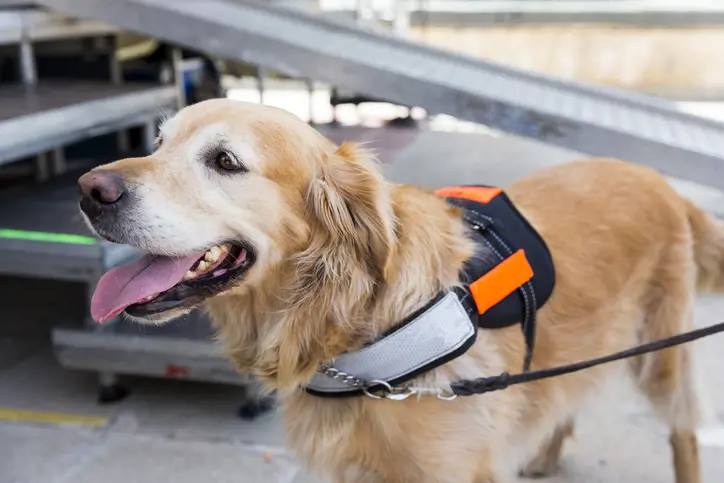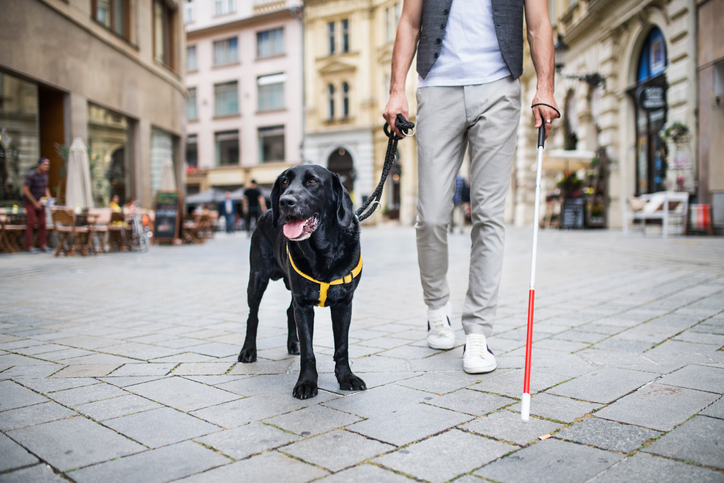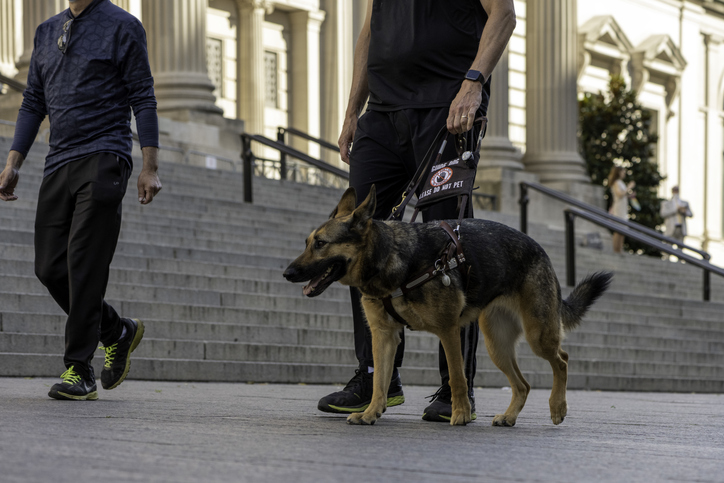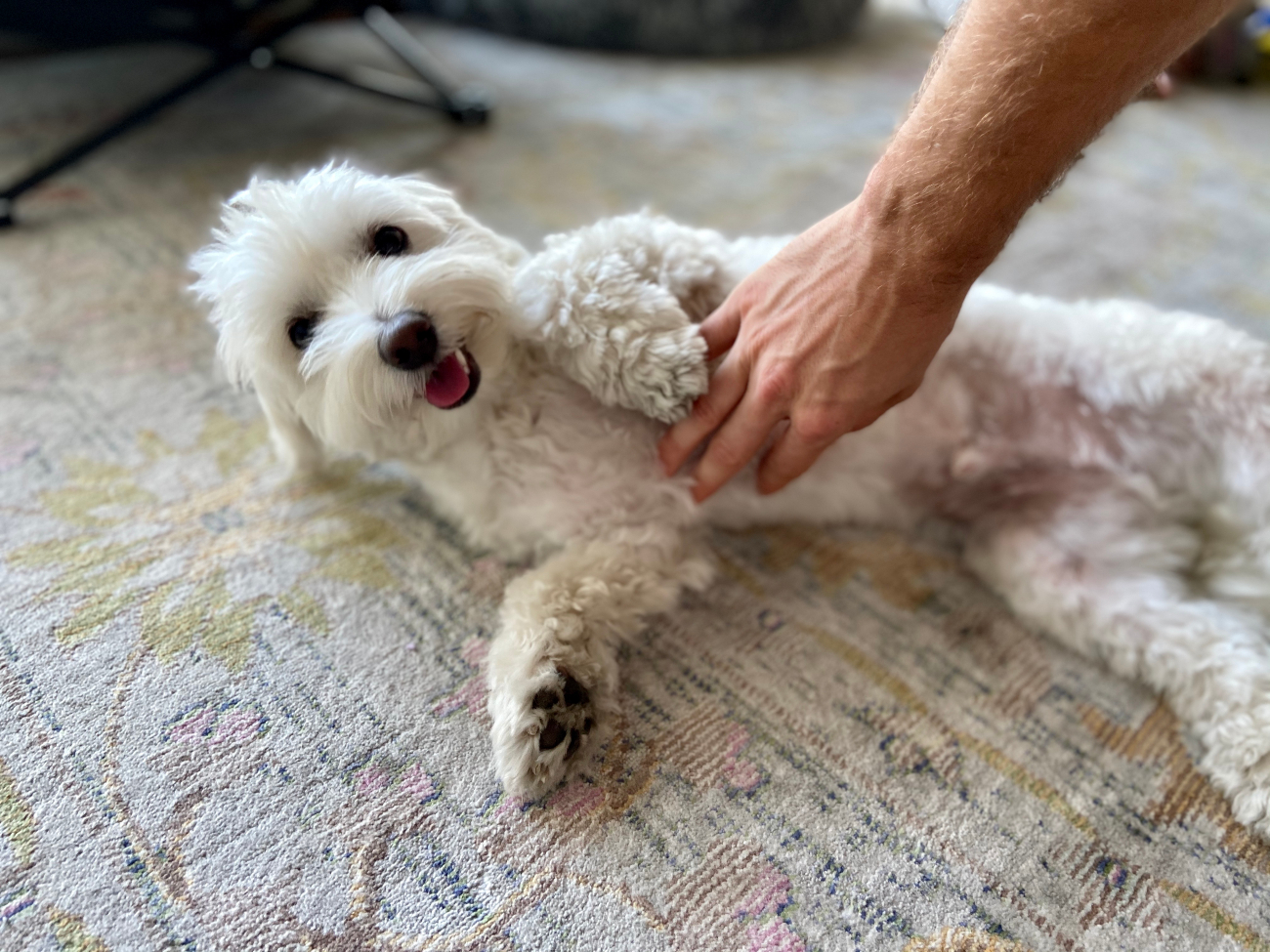What are assistance dogs?
25th February, 2021

We never feel more humble than when we hear the amazing stories of assistance dogs and the help and care they provide to their human owners. While we know our four-legged friends are loving and loyal companions, they also make incredible aids for those with special needs and disabilities who need a helping paw.
In this article we take a look at the different types of assistance dogs and the incredible jobs they do. Prepare to be astounded!
Whether or not your faithful friend is an assistance dog, they still need to be protected by dog insurance suitable for their needs. Get a quick quote from Purely Pets today – you might be surprised at how much you could save.
What are assistance dogs?
An assistance dog is one that has been trained to help their human owner with a disability. Many thousands of people rely on assistance dogs for help with practical day-to-day activities that many of us take for granted. From blind and partially sighted people to those with hearing difficulties, epilepsy, diabetes, physical mobility problems and more – assistance dogs can be a real lifeline and a means to living a more ‘normal’ life.
Unlike other dogs their intense training means they:
-
Won’t just wander around freely when in public.
-
Will sit or lie quietly on the floor next to their owner.
-
Are unlikely to foul in a random public place. Many are trained to toilet on demand in their home garden or when told to by their owner.
When out and about many are instantly recognisable by a high-vis harness or jacket, although the law does not require this to identify them as an assistance dog.

Laws on assistance dogs
Unfortunately, people using assistance dogs have experienced discrimination preventing them from doing everyday activities such as going into shops, restaurants and other businesses. To prevent this from happening, the Equality Act 2010 provides them with the same right to services supplied by shops, banks, hotels, libraries, pubs, taxis and restaurants as everyone else.
Under the Act it’s also illegal for assistance dog owners to be refused access to a taxi or minicab with their assistance dog. While there is no official, government-led register of assistance dogs in the UK, most businesses recognise dogs trained and certified by one of the companies that make up the voluntary coalition Assistance Dogs UK (ADUK).
Are assistance dogs the same as therapy dogs?
Therapy dogs are very different to assistance dogs as they’re not trained to assist a specific person and they’re also not given the same permissions to access public spaces. Therapy dogs are trained to visit hospitals, hospices, schools, nursing homes and mental health facilities and offer comfort and companionship. This is a truly vital service but very different from offering assistance.
Types of assistance dogs
There are so many ways that an assistance dog can be trained to help a human but here are some of the main types.
Guide dogs
When you think of an assistance dog most people immediately think of a guide dog and they’re certainly the most common variety you’ll encounter. Indeed, blind and visually impaired people have been helped by canine companions for centuries.
In general, the breeds favoured for this role are Labrador Retrievers and Golden Retrievers. These smart and lovable dogs take well to the requirements of training and they just love having an important job to do.
Their super-friendly nature and soft features helps them appear less threatening and puts people (who may be afraid of dogs) at ease.
As an additional benefit their natural retrieving instinct means they have ‘soft mouths’. Being able to grip things lightly between their teeth makes them excellent at picking things up for their owners.
Hearing dogs
Dogs are also invaluable for those people with hearing loss and deafness. From doorbells and kitchen timers to smoke alarms and crying babies, these dogs are trained to alert their owner to noises. They’re trained to simply place a paw on their owner and then lead them either away from or towards the noise, depending on the cause.
From the classic Labrador and Golden Retrievers to Cocker Spaniels, Miniature Poodles and the mixed breed Cockapoos these are all breeds with the traits needed to become perfect hearing dogs.
Hearing Dogs for Deaf People has lots more information on these remarkable pups.
Seizure alert and response dogs
So-called seizure dogs are trained to detect the subtle behavioural or chemical changes before someone with epilepsy has a seizure. They may bark or alert other family members if someone has had a seizure, or activate a pre-programmed alarm device.
Some dogs are trained to lie next to someone having a seizure to prevent injury. Indeed, some larger breeds put their bodies between the seizing individual and the floor to help break a fall. Or even move their owners if they’re in a dangerous position.
Incredibly, researchers have found some dogs are able to predict when a seizure is about to happen. Breeds that have shown talent in this area included Golden Retrievers, Poodles, German Shepherds, Border Collies, and Setters.
Diabetic alert dogs
From detecting cancerous cells to smuggled drugs, it’s no secret our pooches possess some super-powered snouts. But are you aware they can even detect subtle changes in your blood glucose levels? While they are undetectable to our meagre noses the scent changes associated with hyperglycemic or hypoglycemic events in those suffering from diabetes can be picked up by a dog.
Although it isn’t a replacement for checking blood sugar levels, it can give a great independence and security for many people with diabetes. These highly-trained lifesavers can also be taught to warn other members of your household or set off an alarm in an emergency.
Allergy detection dogs
Again, using the power of their incredible noses, allergy detection dogs can detect even the smallest traces of certain allergens in the environment (such as peanuts or shellfish) and warn their owner. With life-threatening allergic reactions a hazard for many people, such dogs are proving very popular, particularly among children.
Mobility assistance dogs
Everything from opening and closing doors, switching on lights, ringing doorbells and even helping a person get undressed can be taught to mobility assistance dogs. Given their great size and strength Great Danes are uniquely well-suited to these physical tasks. However, many other breeds can fulfil these roles provided they’re strong enough to assist their owner and potentially provide balance and support.
Autism support dogs
Both children and adults with autism can find social situations difficult but having an autism support dog can be a real help in providing them with reassurance.
Not only can the dog give emotional support and stress relief but they also provide an invaluable way for their owner to connect with other people and gain independence. Find out more about these dogs at Dogs for Good.
The role these dogs play in the lives of their owners is incalculable. Having dog insurance in place for your helpful hound means if they ever find themselves in trouble – whether through injury, loss or theft – they’ll get the help they deserve.
Psychiatric assistance dogs
Psychiatric assistance dogs help many people who are suffering from mental health issues such as depression, anxiety and post-traumatic stress disorder (PTSD).
From military and emergency services personnel to those who’ve experienced abuse or been involved in traumatic accidents, these dogs can provide a much-needed sense of security. What’s more, many owners find that even just having the dog around means they challenge themselves to get out in the world.
If you feel that a psychiatric assistance dog could help you then contact the Psychiatric Assistance Dogs Foundation for more information on suitable breeds and how to train your own dog.
We all worry about our animals from time to time. If you have a dog insurance policy through Purely Pets you can call our 24-Hour Vet Helpline for answers and reassurance.

Can any dog be an assistance dog?
Assistance dogs undergo intense training to make sure they can support their owners in a whole variety of situations. To be successful as an assistance dog they need to have the right temperament but also the right training.
In terms of the dog’s personality, they must:
-
Respond well to instructions from trainers and their owner.
-
Be alert. For example, you want a dog who’ll respond quickly to the onset of a seizure or low blood sugar levels.
-
Be comfortable with attention from their owner.
-
Not be easily distracted by sound, food, and other animals.
-
Have a strong work ethic.
-
Be friendly and gentle with strangers. A dog that reacts aggressively will be no good as an assistance dog.
-
Not be too active. Assistance dogs will need to accompany their owner into many places dogs are not normally allowed. Being calm, obedient and not too energetic in such situations will make things easier.
The successful training of an assistance dog will depend on many factors including:
-
The age at which training begins. A puppy will pick things up a lot faster than a fully grown canine.
-
The breed of the dog. Some dog breeds are simply less trainable than others. Those with a low prey drive tend to be preferred as assistance dogs.
-
The types of tasks that the dog will assist with. For example, psychiatric assistance dogs aren’t usually required to perform complicated tasks, so the training will be easier and shorter than for a guide dog.
-
The training method used. Sending the dog to a training school for professional learning is likely to result in a better outcome.
After assistance dog training, the final step is to ensure the dog is able to keep calm in particular situations when out in public.
According to Assistance Dogs UK (ADUK) these include:
-
Staying with the owner
-
Getting out of a vehicle
-
Entering through a doorway
-
Staying within six feet of the owner
-
Dealing with distractions
-
Dining with the owner in a restaurant
Do ex-assistance dogs make good pets?
Assistance dogs, such as guide dogs, are often bred and trained specifically for that purpose and the majority of them are successful at doing just that.
However, sometimes dogs can be withdrawn from training or from their role as an assistance dog for a range of reasons. Perhaps they didn’t have quite the right temperament or they developed a health condition that meant they were no longer suitable. Other dogs may simply retire from the work and need to be rehomed.
In this event, while they can no longer work as an assistance dog this won’t affect how great they’ll be as a pet. Indeed many of the skills and behaviours they picked up when working may still come in handy in the family home.
If you’re interested in taking on a former assistance dog then contact some of the charities directly for details. ADUK has a list of member organisations worth contacting. Guide Dogs in particular has a process for rehoming both unsuccessful pups and older retired guide dogs.
Even though assistance dogs have been professionally trained, they’re still at risk of theft, illness or injury. That’s why having dog insurance in place is so vital, so you can give them the care and treatment they deserve if they become unwell.
Dog insurance from Purely Pets
However helpful your playful pup is around the house you’re sure to have many adventures during your life together. But whether you’re out for a quiet walk around the block or a day out at the beach sometimes the unexpected can happen.
Getting the right veterinary treatment for injuries and illnesses is a big part of responsible dog ownership, as is having the right dog insurance in place.
Here at Purely Pets, we’ve designed 15 levels of lifetime cover including cover for vets’ fees ranging from £1,000 to £15,000.
Our award-winning policies also come with access to an online policy management portal so you can manage your cover at a time that suits you.
Get a quote for dog insurance from the knowledgeable team at Purely Pets today.
Policy benefits, features and discounts offered may very between insurance schemes or cover selected and are subject to underwriting criteria. Information contained within this article is accurate at the time of publishing but may be subject to change.
Helpful Pages
Recent Posts

What is fading kitten syndrome?
19/04/24
Why do dogs like belly rubs?
15/04/24
Why do Pugs sleep so much?
10/04/24
How to keep cats cool in summer
09/04/24Pet Insurance Quote
- 98% claims paid *
- Claims paid directly to vets
- 24/7 vet video consultations
- Interest free monthly payments
